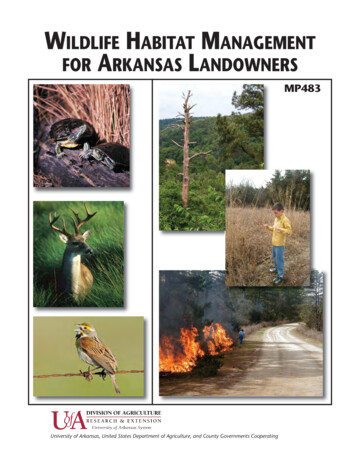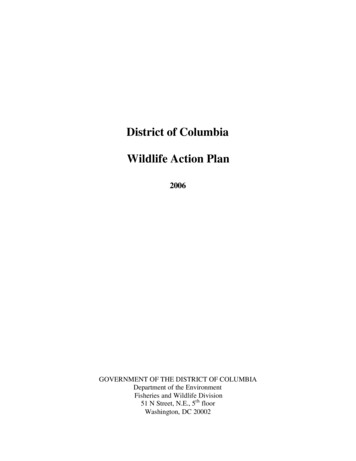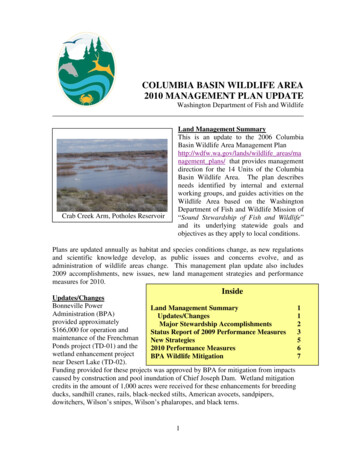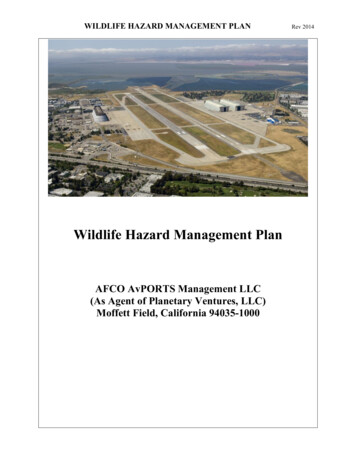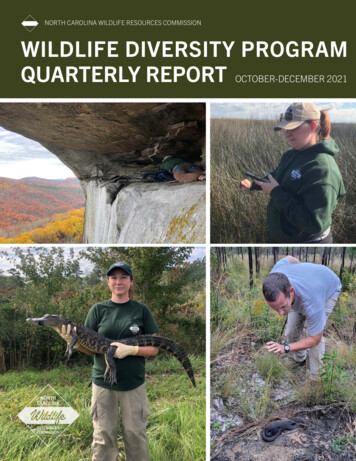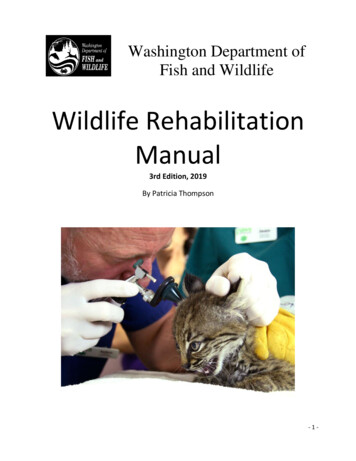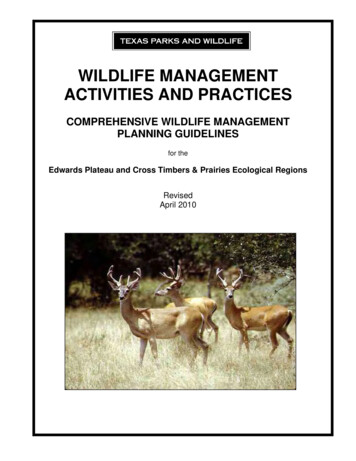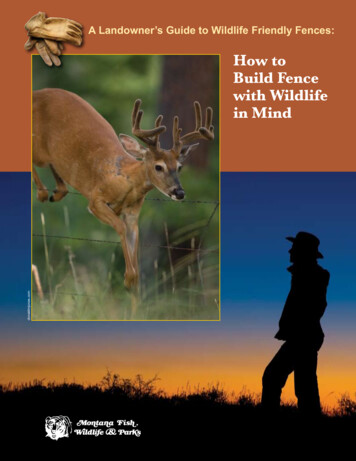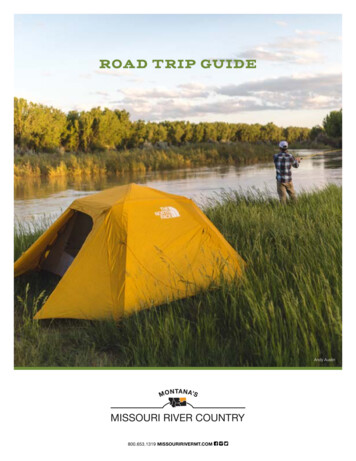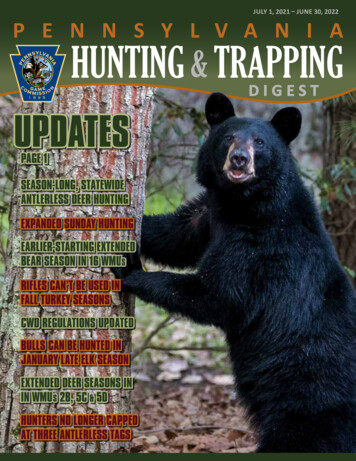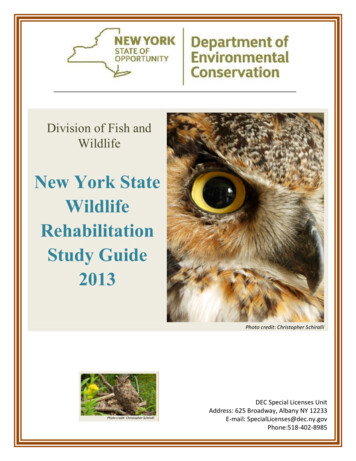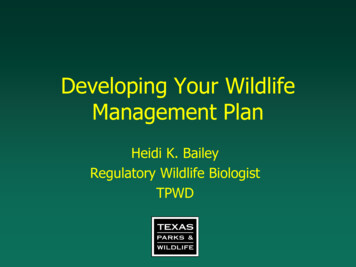
Transcription
Developing Your WildlifeManagement PlanHeidi K. BaileyRegulatory Wildlife BiologistTPWD
STEP 1: DOCUMENT VITAL STATS Name of property (e.g. Dry Creek Ranch, BaileyTract, etc.) County the property is located in Owner(s) name(s) Address Phone numbers (work, home, cell, fax) Land manager contact information (if applicable)
Proposition 11Wildlife Management PLANWhere do I want to gowith my property?
Proposition 11Wildlife Management PLANWhere do I want to gowith my property?How am I going to get there?
Proposition 11Wildlife Management PLANWhere do I want to gowith my property?How am I going to get there?STEP 2: ESTABLISH GOALS & OBJECTIVES
STEP 2: ESTABLISH GOALS ANDOBJECTIVES Maintain agricultural property tax valuation! What wildlife/habitats/vegetative communities amI interested in managing for?
Deer?Big Bucks?Mark F. Wallner
Wild Turkey?Dove?Steve BentsenQuail?
Songbirds?Jim RoetzelKevin T. KarlsonRob Curtis
Native Prairie?Hardwood Forest?
Greatest Diversity?Karl H. SwitakTim Zurowski
Feral Hogs?
Feral Hogs?NOT!!!
STEP 2: ESTABLISH GOALS ANDOBJECTIVES Maintain agricultural property tax valuation! What wildlife/habitats/vegetative community am Iinterested in managing for? Do I have multiple goals or objectives?
Multi-purpose or multi-species management? Heidi Bailey ?Lenoard Lee Rue III
What other plans/interests do youhave?
REALITY CHECKWhat you have to work with to begin with(acreage, habitat types, soil types, time, , etc.) will largely help you todetermine what goals and priorities arerealistic.
For example,15 acres of
So .establish a detailed andREALISTIC goal/set of goals.Example: “To manage native habitats to improvethe quality and quantity of white-tailed deer forlease-hunting”-Increase deer food and cover to increase deer utilization.-Manage deer population to increase production of maturebucks.-Harvest of only mature (4.5 years ) bucks-Maintain buck/doe ratio of 1:3 or better-Maintain carrying capacity of 1 deer: 20 acres
and a nongame example might be:“To improve recreational bird watchingopportunities by creating and maintainingnesting, feeding, and breeding habitat suitablefor native bird populations, with specialemphasis on grassland species.”-Improve vegetative diversity throughout the property.-Reintroduce native warm season grasses to pastures.
and yet another example:“To improve and enhance the habitat forwhite-tailed deer, wild turkey, bobwhitequail, and other game and nongamewildlife in conjunction with running asuccessful cow-calf operation.”
Plan Development Back to the Computer! Research the“Wildlife TaxValuationInformational CD” Print off a blankWMP form PWD885-W7000
STEP 3: PROPERTY INFORMATION How many total acres is the property? What types of vegetative communities/habitattypes are on the property?- Divide the total acreage out into estimatedamounts of each habitat type.- Example: 40% upland pine/hardwood forest,35% Bermudagrass pasture, 15% native pasture,and 10% water (lake and ponds).- OR, if possible, give actual acreage amounts ofeach habitat type.
SOME EXAMPLES OF HABITATTYPES Improved Grassland (Tame Pasture) Unimproved Grassland (Native Pasture) Bottomland Hardwood Forest Pine Plantation Upland Mixed Pine/Hardwood Forest Oak Woods Riparian Zone Wetland/Marsh Cultivation (Ag. Crops, Food Plots)
STEP 3: PROPERTY INFORMATION How many total acres is the property? What types of vegetative communities/habitattypes are on the property? Species targeted for management? Is the property high fenced?
STEP 3: PROPERTY INFORMATION How many total acres is the property? What types of vegetative communities/habitattypes are on the property? Species targeted for management? Is the property high fenced? Is the property leased for hunting?
STEP 3: PROPERTY INFORMATION How many total acres is the property? What types of vegetative communities/habitattypes are on the property? Species targeted for management? Is the property high fenced? Is the property leased for hunting? Property location.-Be as detailed as possible. (e.g. “In centralHenderson County, 6 miles NW of Athens on thenorth side of CR 3913)-Provide a surveyor’s plat or a map, if available.
STEP 4: CURRENT HABITATDESCRIPTION Where in the county is the property?
STEP 4: CURRENT HABITATDESCRIPTION Where in the county is the property? What ecoregion is the property in? (e.g.Blackland Prairie, Post Oak Savannah,Pineywoods, etc.)Craig McMahan
STEP 4: CURRENT HABITATDESCRIPTION Where in the county is the property? What ecoregion is the property in? (e.g.Blackland Prairie, Post Oak Savannah,Pineywoods, etc.) What vegetation is associated with the varioushabitat types on your property?-Do-it-yourself vegetative inventory-County soil map from NRCS (old SCS)
What’s in a soil map? Soil types Detailed description of each soil-acidity-permeability-erosion hazard-available water capacity-wildlife habitat potential-general land management recommendations
What’s in a soil map? Soil types Detailed description of each soil Common native vegetation for each soil type Farming and planting recommendations Information on the best places (soil types) to plantfood plots, create ponds/wetlands, etc.
STEP 4: CURRENT HABITATDESCRIPTION Where in the county is the property? What ecoregion is the property in? (e.g.Blackland Prairie, Post Oak Savannah,Pineywoods, etc.) What vegetation is associated with the varioushabitat types on your property? What are the predominant soil types on yourproperty?
STEP 4: CURRENT HABITATDESCRIPTION Where in the county is the property? What ecoregion is the property in? (e.g.Blackland Prairie, Post Oak Savannah,Pineywoods, etc.) What vegetation is associated with the varioushabitat types on the property? What are the predominant soil types on theproperty? What water features (if any) are there on theproperty?
STEP 5: PAST HISTORY OF LANDUSE How long has the property been under currentownership? What had the land been used for previously?-Farming-Grazing-Cows, horses, goats, exotics?-How many head?-Timber production-Hunting-How heavy was past hunting pressure?
STEP 6: PLANNED USE“Wildlife management for recreational use; to bevalued under 1-d-1(w) wildlife management useappraisal.”
STEP 7: PLANNED MANAGEMENTACTIVITIES AND PRACTICES Habitat Control Erosion Control Predator Control Providing Supplemental Water Providing Supplemental Food Providing Supplemental Shelter Census Counts to Determine Populations
STEP 7: PLANNED MANAGEMENTACTIVITIES AND PRACTICES HABITAT CONTROL-Grazing Management-Prescribed Burning-Range Enhancement-Brush and TimberManagement-Riparian Managementand Enhancement-Prescribed Control ofSpecies-Wildlife Restoration
STEP 7: PLANNED MANAGEMENTACTIVITIES AND PRACTICES EROSION CONTROL-Pond Construction-Gully Shaping-Streamside, Pond,Wetland Restoration-Native PlantEstablishment on tablish WaterDiversion
STEP 7: PLANNED MANAGEMENTACTIVITIES AND PRACTICES PREDATOR CONTROL-Predator Management-Feral Hog Control-Imported Red Fire AntControl-Control of Brown-headedCowbirds-Grackle/Starling Control
STEP 7: PLANNED MANAGEMENTACTIVITIES AND PRACTICES PROVIDINGSUPPLEMENTALWATER-Mash/WetlandRestoration orDevelopment-Well/Trough/WindmillOverflow-Spring Development orEnhancement-Wildlife Water Guzzlers
STEP 7: PLANNED MANAGEMENTACTIVITIES AND PRACTICES PROVIDINGSUPPLEMENTAL FOOD-Grazing Management-Prescribed Burning-Range Enhancement-Food Plots-Feeders and MineralSupplementation-Managing ImprovedPastures, Fields, Croplands-Transition Mgmt. of TameGrass Pastures
STEP 7: PLANNED MANAGEMENTACTIVITIES AND PRACTICES PROVIDINGSUPPLEMENTALSHELTER-Nest Boxes/Bat Boxes-Brush Piles-Fence Line Management-Hay Meadow, Pasture, andCropland Mgmt. for Wildlife-Half-cutting Trees or Shrubs-Woody Plant/Shrub Estab.-Natural Cavity/SnagDevelopment
STEP 7: PLANNED MANAGEMENTACTIVITIES AND PRACTICES CENSUS COUNTS TODETERMINEPOPULATIONS-Spotlight Counts-Daylight Wildlife Counts-Harvest Data Collectionand Record-Keeping-Browse Utilization Surveys-Song Bird Transects andCounts-Point Counts-Track Counts
In order for a landowner to qualify forthe 1-d-1(w) wildlife management useappraisal they must implement andcomplete a minimum of onemanagement practice from at least threeof the seven wildlife managementactivities each year.
STEP 8: SPECIFIC HABITATMANAGEMENTRECOMMENDATIONS Flesh out what exactly you plan on doing.-Which management practices under which of theseven management activities are planned.-Timeline? List target indigenous species. Be detailed.
STEP 9: DOCUMENTEVERYTHING Turn in new Wildlife Management Planannually or whenever changes are made. If required, turn in Prop 11 ActivityReporting Form to tax office every year. Save receipts. Take pictures. Make maps of planned project areas.
STEP 10: HAVE FUN WITH IT!
STEP 3: PROPERTY INFORMATION How many total acres is the property? What types of vegetative communities/habitat types are on the property? - Divide the total acreage out into estimated amounts of each habitat type. - Example: 40% upland pine/hardwood forest, 35% Bermudagrass pasture, 15% native pasture, and 10% water (lake and ponds).
